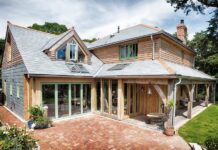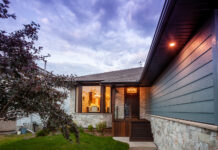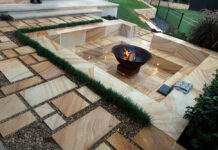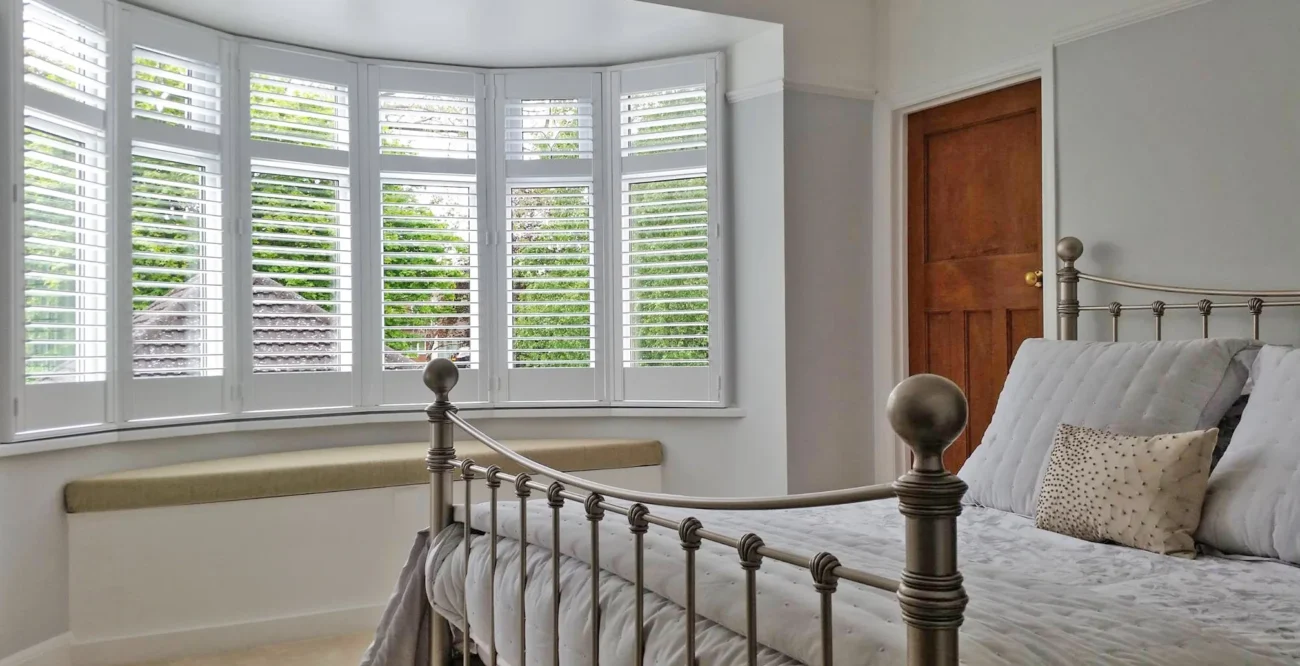
Choosing the right material for plantation shutters is a critical decision for homeowners. Each material offers distinct advantages and aesthetic qualities. This comprehensive guide will delve deep into the different materials available for plantation shutters, helping you make an informed choice for your windows.
Plantation shutter installations, characterized by their wide louvers and robust design, are a popular choice for window treatments. Their functionality combined with timeless elegance allows homeowners to enhance the aesthetic appeal of their homes while ensuring privacy and optimal light control. Selecting the right material for your plantation shutters is essential for durability, functionality, and aesthetic harmony with your interior décor.
Material Options
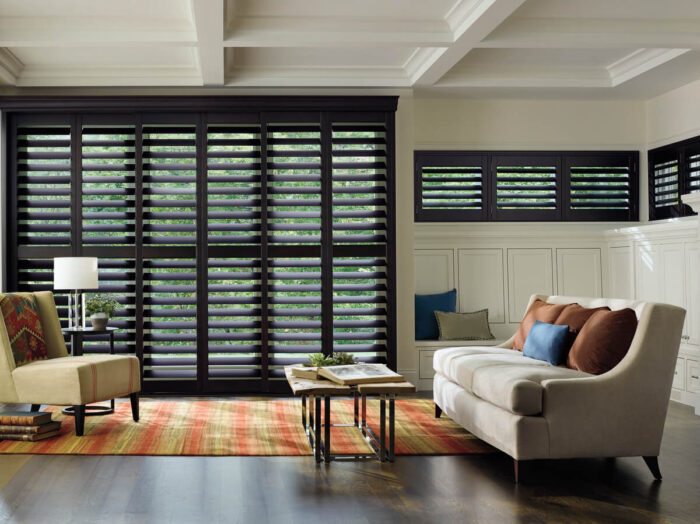
Wood
Pros
- Aesthetic Appeal: Offers a classic, warm, and rich look.
- Customizable: Can be painted or stained in any color.
- Lightweight: Ideal for large windows.
Cons
- Cost: Generally more expensive.
- Maintenance: Requires more care to prevent damage from moisture or sun exposure.
Faux Wood (Polywood or PVC)
Pros
- Durability: Resistant to moisture, making it ideal for humid areas.
- Cost-effective: Generally less expensive than real wood.
- Low Maintenance: Easy to clean and maintain.
Cons
- Weight: Heavier, which might not be suitable for large windows.
- Limited Customization: Color and finish options might be limited.
Aluminum
Pros
- Durability: Strong and long-lasting.
- Modern Look: Offers a sleek, contemporary design.
- Versatile: Suitable for indoor and outdoor use.
Cons
- Aesthetic Limitation: Might not suit traditional home décor.
- Heat Conduction: Can make rooms hotter in summer.
Choosing the Right Material
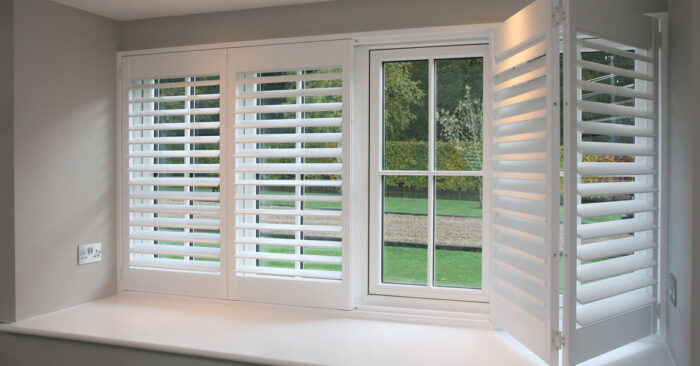
Assess the Environment
Consider the environment and location of your windows. For humid or wet areas like bathrooms, faux wood or aluminum may be more suitable due to their moisture resistance.
Consider Aesthetic Preferences
Align your material choice with your home’s design aesthetic. Wood shutters complement traditional designs, while aluminum suits modern, minimalist decors.
Evaluate Budget Constraints
Analyze your budget. If cost is a concern, faux wood provides durability and aesthetic appeal at a more affordable price point compared to real wood.
Delving Deeper
Detailed Material Analysis
Wood
Wood shutters provide unmatched natural beauty, insulation properties, and customization options. Choose from various types, including poplar, teak, and basswood. However, ensure regular maintenance to retain their pristine condition.
Faux Wood
Faux wood shutters offer a balance of affordability, durability, and aesthetic appeal. They emulate the look of real wood, ensuring a stylish appearance while being ideal for high-moisture areas.
Aluminum
Aluminum shutters stand out for their robustness and modern appeal. They are perfect for external applications or achieving an industrial look indoors.
Matching Materials with Room Types
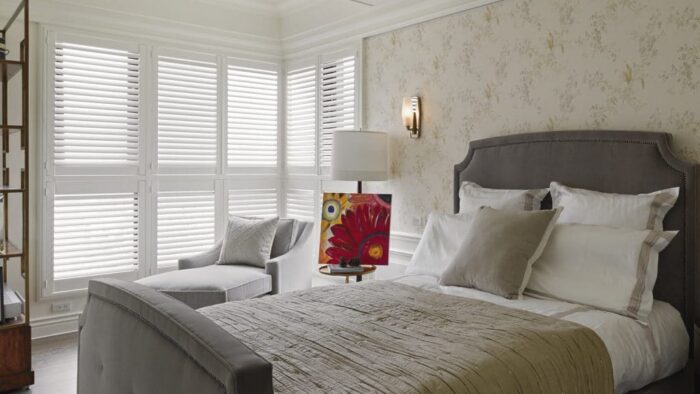
Bedrooms
For bedrooms, wood shutters add warmth and a cozy ambiance with their natural look, also providing excellent insulation.
Bathrooms
In bathrooms, faux wood or aluminum shutters are ideal, ensuring resistance to moisture and steam.
Living Areas
For living areas, all materials are suitable. Choose based on aesthetic preference, budget, and insulation needs.
The In-depth Comparison
Wood vs. Faux Wood
When comparing wood and faux wood, the main considerations should be aesthetics, budget, and environmental resistance. While wood offers a classic and timeless appeal, it comes at a higher cost and requires more maintenance. Faux option, on the other hand, provides a balance of cost-efficiency, durability, and practicality, especially in high-humidity areas.
Wood vs. Aluminum
Comparing wood and aluminum, the distinction lies in design aesthetics and functional properties. Wood offers a warm and traditional look with good insulation, while aluminum brings a sleek, modern design, and robust strength. However, aluminum may not be the best insulator, which is a significant consideration for extreme climates.
Faux Wood vs. Aluminum
In contrasting faux wood and aluminum, think about the look, maintenance, and durability. Both materials are low-maintenance and durable, with aluminum being particularly strong. Faux wood offers a warmer, homely appearance, whereas aluminum gives a contemporary, industrial feel.
Energy Efficiency
Energy efficiency is a vital consideration when selecting the material for your plantation shutters. The choice of material can significantly impact your home’s energy consumption and, consequently, your utility bills. Wood shutters, known for their excellent insulation properties, create a barrier against outdoor temperature fluctuations.
This insulation helps maintain a comfortable indoor environment year-round, potentially reducing the need for heating or cooling. On the other hand, aluminum shutters, while durable and modern in design, may not provide the same level of insulation and could contribute to increased energy costs in extreme climates. Faux wood shutters strike a balance, offering decent insulation, particularly suitable for areas with fluctuating temperatures.
By factoring in energy efficiency, you can make a sustainable choice that benefits both your comfort and your wallet. And when it comes to the overall energy efficiency of your home, don’t forget to explore the options provided by Timberline windows and doors. Their products and services can complement your choice of shutters, ensuring that your home remains energy-efficient and comfortable year-round.
Installation Considerations
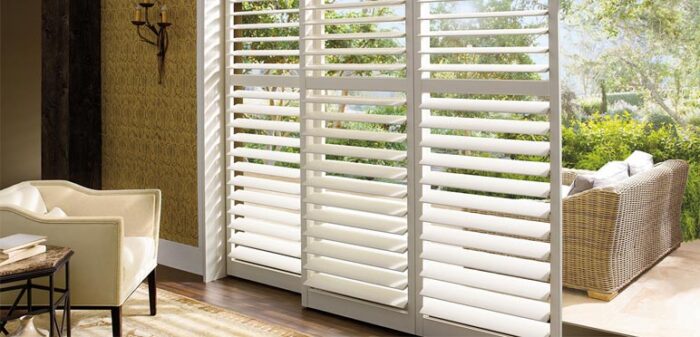
Expert Assistance
When choosing the material for your plantation shutters, consider seeking expert assistance. Professionals can provide insights into the best materials for your specific needs, ensuring that your choice not only enhances the aesthetics but also offers durability and functionality.
Customization Options
Review the customization options for each material. While wood shutters can be easily customized in terms of colors and finishes, faux wood and aluminum might have some limitations in this aspect.
Maintenance and Longevity
Regular Upkeep
Regardless of the material chosen, regular upkeep is essential to maintain the appearance and functionality of your plantation shutters. Wood shutters need timely re-finishing to protect against wear and tear. Faux wood and aluminum shutters, being more durable, require less intensive care.
Long-Term Investment
View your plantation shutters as a long-term investment. Evaluate the longevity of each material and consider spending a bit more initially for greater durability and satisfaction in the long run.
Potential Challenges
Climate Compatibility
Ensure your chosen material is climate compatible. Aluminum may not be suitable for coastal areas due to potential corrosion, while wood might not be ideal for highly humid regions.
Future Décor Changes
Consider potential future décor changes. Ensure your chosen material allows flexibility for adjustments or refinishing to align with any new décor themes or styles you might adopt in the future.
FAQs
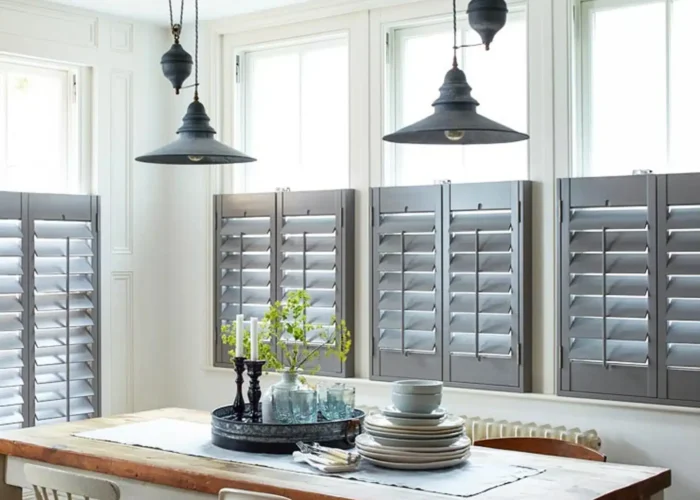
Can I Use Different Materials in Different Rooms?
Absolutely! Customize material choices based on each room’s specific needs and conditions.
Is Faux Wood as Good as Real Wood?
Faux wood offers excellent durability and moisture resistance, but it may not provide the same insulation and natural aesthetic as real wood.
Are Aluminum Shutters Suitable for All Climates?
Aluminum shutters are robust and durable, but consider their heat conduction properties in extremely hot climates.
Final Thoughts
In conclusion, the best material for your plantation shutters depends on various factors including location, climate, room type, aesthetic preference, and budget. Wood shutters offer traditional elegance and excellent insulation but require proper care and maintenance.
Faux wood shutters are a cost-effective, durable alternative, ideal for high-moisture areas. Aluminum shutters, on the other hand, provide robustness and a modern look, suitable for both internal and external applications.
Consider all these factors meticulously, and make a choice that not only enhances the aesthetic appeal of your home but also ensures longevity, functionality, and satisfaction in the long run. It’s not just about making a house look beautiful, it’s about making it a home – comfortable, personal, and uniquely yours.


